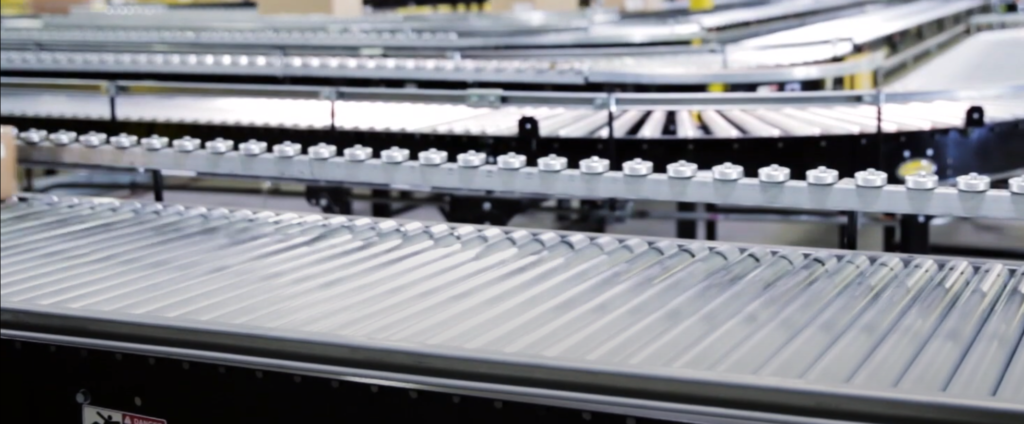(Which Option is Right for Your Facility?)

Upgrading your facility is a big investment for any company.
Whether to recondition an existing conveyor system or invest in a brand new one is not an easy decision to make, but in the materials handling industry, it’s an inescapable choice you’re faced with at some point.
There isn’t a broad, clear cut answer, as there are benefits and disadvantages associated with either option.
In this article, we’ll discuss everything you need to know, so you can make the right decision for your warehouse or facility, and ultimately, your business.
Reconditioning An Existing Conveyor Systems
BENEFITS :
Quick system Turnaround. Conveyor manufacturing lead times are longer than ever. Manufacturers have been under strain since the global pandemic started. Constantly changing protocols have posed new challenges to the shipping industry and have caused many delays getting products to their destination.
It’s for this reason that there’s an advantage to buying an existing conveyor system — lead times for buying reconditioned systems are usually very short because the existing inventory is readily available. Often, the system is already fully equipped and ready to install.
Reconditioned systems can deliver higher ROI. The cost of buying an existing system is often significantly less than building a new system. If you buy a used system for half of the price of a new one and still achieve the same level of output, the return on your investment will be much higher. What you do with those savings is up to you!
DISADVANTAGES :
Time lost retrofitting an existing system. When you implement an existing system, you are purchasing a system that was designed specifically for the facility it was previously in, not yours.
Retrofitting the conveyor to fit your own warehouse or facility could become quite time-consuming, as well as expensive. Unforeseen issues such as purchasing new material or building codes can arise quickly — and slow you down tremendously.
No warranty. When you buy used, there is usually no warranty left on the system, which means any faulty components will need to be replaced out of pocket and you’ll likely have to troubleshoot issues on your own.
If buying an existing system seems out of the equation for your company, don’t stress. There are many advantages of building a new conveyor system.
Building a New Conveyor System
BENEFITS :
Get a system designed to your facility’s specifications. Choosing to build a new conveyor system from the ground up gives you ergonomic flexibility you will not get with retrofitting. Your brand new system will be designed specifically to fit your warehouse or facility. It will also be purposely constructed to operate with the product and materials your company handles. When you construct a brand new system, you don’t have to make compromises — you can build the system exactly the way you want it.
Shorter learning curve for your team. One significant advantage of fabricating a system for yourself is that your team will already know the ins and outs of each piece of the system. An installation company will work alongside your team from the very beginning when building the system. This will simplify upkeep, leading to less interruptions during production, and more intelligent troubleshooting when something goes wrong. The planning of the system will ensure that it is compliant with current building codes, and maintenance teams will know what to anticipate for preservation.
There’s a warranty. With a new system, all parts will still have warranties. If a component within the system is faulty, there is still the security of being under warranty. This will reduce out-of-pocket costs in the future for routine maintenance as well as any unanticipated difficulties.
Up to date technology. Fabricating a new system can ensure that your system will be at the forefront of the newest technologies within your industry. All components within your conveyor system will be built with these new technologies in mind. Newer models will require fewer updates, less often, and will already be functional for any materials and products you handle from the start. A recycled system may be antiquated and will thus require more effort to bring the system up to date.
DISADVANTAGES :
Longer supply chain lead times. During our nation’s current situation with the pandemic, manufacturer shipping periods have been slowed significantly. Scheduling to have materials delivered within optimal windows of time may prove to be more challenging than ever. Some companies are listing manufacturing and transport times up to 12 months in advance. So if you are counting on a system anytime soon, waiting on materials could cause you to lose a large period of productivity while you wait for supplies.
Overall higher cost. The most important factor to consider when building a new conveyor system is the overall cost. Purchasing a new system is quite expensive and you must factor in the additional costs of preparation and installation. The final tally here can be daunting for any company, and your business will need to establish your ultimate budget and determine if the ROI makes sense.
There are many other individual factors to consider when selecting which is best for your facility or distribution center. However, in the end it will depend on three things, your time, your needs, and your budget.
If you are unsure which option is best for you, give us a call. Our experienced team will guide you in the right direction with your current situation, your future goals, and how we can help long term. Call to get started at (844) 845-7580 or send us an email at info@lafayette-engineering.com.




